- Exmark Lawn Mower Service Tools & Equipment
- Service Table for Exmark Lawn Mower Won’t Start
- How to Check the Battery
- How to Check the Fuel Filter
- How to Examine the Air Filter
- How to Check the Spark Plug
- How to Inspect the Ignition System
- How to Test the Carburetor
- How to Check the Oil Level
- How to Check the Safety Switch
- Exmark Lawn Mower Won’t Start F.A.Q.
Having a well-maintained lawn mower is essential for keeping your lawn looking pristine and beautiful. However, like any mechanical equipment, lawn mowers can sometimes encounter issues, and one common problem is when your Exmark lawn mower won’t start. If you’re facing this frustrating situation, you may be wondering what’s causing the problem and how to fix it.
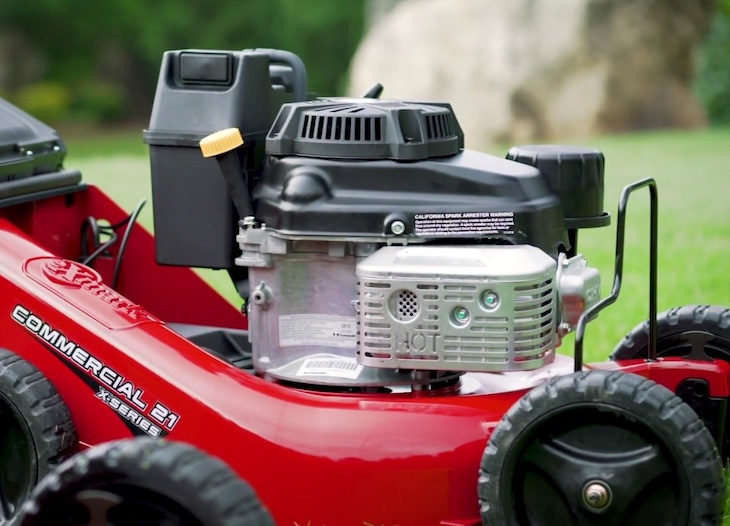
In this guide, we’ll provide troubleshooting solutions to help you diagnose the issues, both visually and within the engine and carburetor parts, so you can get your Exmark lawn mower up and running again in no time. Whether it’s a lack of oil, power issues, fuel consumption problems, or other potential issues, we’ll guide you through the steps to identify the root cause and suggest necessary replacements or repairs. Let’s get your Exmark lawn mower back on track, so you can continue to maintain your lawn with ease and efficiency.
Exmark Lawn Mower Service Tools & Equipment
To troubleshoot an Exmark lawn mower that won’t start, you’ll need a few basic tools and equipment. Here’s a list of the most commonly used tools for diagnosing and fixing the issues:
- Socket set: For removing bolts and nuts on various engine components.
- Screwdrivers (both flathead and Phillips): For loosening and tightening screws on the engine and carburetor parts.
- Spark plug wrench: To remove and inspect the spark plug.
- Pliers: Useful for gripping and holding various components during inspection.
- Multimeter: To check for electrical issues and continuity in the circuits.
- Fuel pressure gauge: To measure fuel pressure in the fuel system.
- Compression tester: To check engine compression and diagnose engine problems.
- Oil dipstick: To check the engine oil level.
- Safety equipment: Gloves, safety goggles, and ear protection to ensure your safety during the troubleshooting process.
Keep in mind that the specific tools needed may vary based on the model and type of Exmark lawn mower you have. Always refer to the manufacturer’s manual for any specific tools or equipment recommended for your model. Additionally, having a clean and well-organized workspace will make troubleshooting more efficient and help you keep track of any removed parts or components.
Service Table for Exmark Lawn Mower Won’t Start
Below is a service table for troubleshooting an Exmark lawn mower that won’t start. The table includes common problems, possible causes, and suggested solutions for each issue. This should help you diagnose and fix the problem efficiently:
| Problem | Possible Causes | Suggested Solutions |
|---|---|---|
| Engine doesn’t crank | Dead battery | Charge or replace the battery. |
| Faulty starter motor | Check and replace the starter motor. | |
| Loose or corroded battery cables | Tighten or clean battery connections. | |
| Engine cranks but won’t start | Empty fuel tank | Refill the fuel tank with fresh fuel. |
| Clogged fuel filter | Replace the fuel filter. | |
| Stale fuel | Drain old fuel and add fresh fuel. | |
| Choked carburetor | Adjust the choke or clean the carburetor. | |
| Dirty or fouled spark plug | Clean or replace the spark plug. | |
| Ignition system issues | Check ignition coil, spark plug wire, etc. | |
| Engine starts but stalls | Clogged air filter | Clean or replace the air filter. |
| Carburetor issues | Clean or rebuild the carburetor. | |
| Water in fuel | Drain the fuel tank and add fresh fuel. | |
| Faulty ignition switch | Check and replace the ignition switch. | |
| Engine lacks power | Dirty air filter | Clean or replace the air filter. |
| Low engine oil level | Check and refill engine oil to proper level. | |
| Worn or damaged spark plug | Replace the spark plug. | |
| Clogged fuel lines | Clean or replace the fuel lines. | |
| Engine overheats | Low engine oil level | Check and refill engine oil to proper level. |
| Dirty cooling fins on engine | Clean the cooling fins to improve airflow. | |
| Faulty cooling system | Check cooling system components for issues. | |
| Incorrect oil viscosity | Use the recommended oil viscosity for the engine. |
Please note that this table provides general troubleshooting steps, and the specific issues may vary depending on the model and type of Exmark lawn mower you have. Always refer to the manufacturer’s manual or seek professional assistance if needed for more complex problems.
How to Check the Battery
To check the battery on your Exmark lawn mower when it won’t start, follow these step-by-step instructions:
- Safety First: Ensure the lawn mower is parked on a flat, level surface, and engage the parking brake. Turn off the engine and remove the ignition key to prevent accidental starting.
- Locate the Battery: Find the battery compartment on your Exmark lawn mower. It is usually located under the seat or in the engine compartment, depending on the model.
- Inspect the Battery Connections: Carefully inspect the battery terminals for any signs of corrosion, rust, or loose connections. Corroded or loose connections can prevent the battery from delivering power to the starter.
- Clean the Battery Terminals: If you notice any corrosion on the battery terminals, use a wire brush or battery terminal cleaner to clean them. Gently remove any rust or debris, ensuring that the terminals are clean and shiny.
- Check Battery Voltage: Using a multimeter or voltmeter, set it to the DC voltage range. Connect the red probe to the positive terminal of the battery and the black probe to the negative terminal. A fully charged battery should read around 12.6 to 12.8 volts.
- Charge the Battery: If the battery voltage is below 12.4 volts, it might need to be recharged. Connect the battery to an appropriate battery charger and follow the manufacturer’s instructions for charging.
- Load Test the Battery (Optional): If you have access to a battery load tester, perform a load test to check the battery’s ability to hold a charge under load. This will help determine if the battery needs replacement.
- Inspect the Battery Cables: Check the battery cables for any signs of damage or fraying. Replace any damaged cables as necessary.
- Reconnect the Battery: After charging or testing the battery, reconnect the battery cables securely to the appropriate terminals. Ensure the positive cable (usually red) connects to the positive terminal (+), and the negative cable (usually black) connects to the negative terminal (-).
- Attempt to Start the Engine: Once the battery is reconnected, try starting the engine. If the engine cranks and starts, the battery was likely the issue. If the problem persists, further diagnosis may be needed.
If you still encounter issues after checking the battery, it’s recommended to seek professional assistance or consult the Exmark dealer or service center for further troubleshooting and repair.
How to Check the Fuel Filter
Ensure the lawn mower is parked on a flat, level surface, and engage the parking brake. Turn off the engine and remove the ignition key to prevent accidental starting.To check the fuel filter on your Exmark lawn mower when it won’t start, follow these step-by-step instructions:
- Locate the Fuel Filter: The fuel filter is typically located between the fuel tank and the engine. On most Exmark lawn mowers, it is a small, cylindrical or inline filter.
- Identify the Fuel Lines: Trace the fuel lines from the fuel tank to the engine. The fuel filter should be in line with these fuel lines.
- Prepare for Fuel Loss (If Required): If your lawn mower has a fuel filter with built-in shut-off valves, close the valves to prevent fuel spillage when removing the filter. If not, you may need to drain the fuel tank partially to minimize fuel loss.
- Remove the Fuel Filter: Using a wrench or pliers, carefully loosen and remove the clamps or fittings securing the fuel lines to the fuel filter. Be cautious as fuel may still be present in the lines.
- Inspect the Fuel Filter: Once the fuel lines are disconnected, remove the fuel filter from the mower. Examine the filter for signs of clogging, dirt, or debris. A clogged filter can prevent fuel from reaching the engine and cause starting issues.
- Replace the Fuel Filter (If Necessary): If the fuel filter appears dirty or clogged, it’s best to replace it with a new one. Make sure to use the correct replacement filter for your Exmark mower model.
- Reconnect Fuel Lines: Attach the fuel lines to the new fuel filter and secure them with the clamps or fittings. If you partially drained the fuel tank, refill it with fresh gasoline.
- Check for Leaks: Double-check all connections to ensure they are tight and secure. Turn the fuel shut-off valves (if present) to the open position.
- Attempt to Start the Engine: With the new or cleaned fuel filter in place and the fuel system reconnected, try starting the engine. If the engine cranks and starts, the fuel filter was likely the issue. If the problem persists, further diagnosis may be needed.
If you are unsure about inspecting or replacing the fuel filter, or if the issue persists after checking the fuel filter, it’s recommended to seek professional assistance or consult the Exmark dealer or service center for further troubleshooting and repair.
How to Examine the Air Filter
To examine the air filter on your Exmark lawn mower when it won’t start, follow these step-by-step instructions:
- Locate the Air Filter Housing: The air filter housing is usually located on top of the engine or on the side, depending on the Exmark mower model. It is a box-like or cylindrical structure with a cover.
- Remove the Air Filter Cover: Use a screwdriver, nut driver, or a wrench to remove the screws or fasteners securing the air filter cover. Some models may have a latching mechanism that requires releasing to open the cover.
- Inspect the Air Filter Element: After removing the air filter cover, you’ll see the air filter element inside. Carefully take out the air filter from the housing and examine its condition.
- Check for Dirt and Debris: Look for signs of dirt, debris, or excessive dust accumulation on the air filter. A clogged or dirty air filter can restrict airflow to the engine and cause starting issues.
- Clean or Replace the Air Filter (If Necessary): If the air filter appears dirty or clogged, it’s essential to either clean it or replace it with a new one. If it’s a foam-type filter, gently wash it with mild soap and water, then allow it to dry thoroughly. If it’s a paper-type filter, it should be replaced with a new one.
- Clean the Air Filter Housing: While the air filter is removed, inspect the inside of the air filter housing for any dirt or debris. Use a soft brush or cloth to clean the housing if needed.
- Reinstall the Air Filter: Once the air filter is clean or replaced, place it back into the air filter housing. Make sure it fits securely and correctly into the housing.
- Replace the Air Filter Cover: Position the air filter cover back onto the housing, and secure it with the screws or fasteners you removed earlier. Make sure the cover is properly seated to prevent any air leaks.
- Attempt to Start the Engine: With the clean or new air filter in place and the air filter cover securely attached, try starting the engine. If the engine cranks and starts, the air filter was likely the issue. If the problem persists, further diagnosis may be needed.
If you are unsure about examining or replacing the air filter, or if the issue persists after checking the air filter, it’s recommended to seek professional assistance or consult the Exmark dealer or service center for further troubleshooting and repair.
How to Check the Spark Plug
To inspect the spark plug on your Exmark lawn mower when it won’t start, follow these step-by-step instructions:
- Locate the Spark Plug: The spark plug is typically located on the side of the engine cylinder head. It has a rubber boot connected to a wire and is secured to the engine with a hexagonal nut or spark plug socket.
- Remove the Spark Plug Boot: Gently pull off the rubber boot covering the spark plug. Be sure to grasp the boot firmly by the rubber and not the wire to avoid damaging the ignition system.
- Clean the Area Around the Spark Plug: Use a brush or compressed air to remove any debris or dirt from around the spark plug. This prevents any dirt from falling into the cylinder when you remove the plug.
- Remove the Spark Plug: Use a spark plug socket or a suitable wrench to loosen and remove the spark plug from the cylinder head. Turn it counterclockwise until it comes free. Be careful not to over-tighten or cross-thread the plug during removal.
- Inspect the Spark Plug Condition: Examine the spark plug carefully for signs of wear, damage, or fouling. Check the electrode and the ceramic insulator for any buildup of carbon deposits, oil, or wetness.
- Check Spark Plug Gap: If the spark plug appears to be in good condition, measure the spark plug gap using a gap gauge. The correct gap should match the specifications in your mower’s owner’s manual.
- Clean or Replace the Spark Plug (If Necessary): If the spark plug is fouled with carbon deposits or oil, it can be cleaned using a wire brush or spark plug cleaner. However, if the plug is damaged, worn, or excessively fouled, it’s best to replace it with a new one.
- Install the Spark Plug: Carefully thread the spark plug back into the cylinder head by hand to avoid cross-threading. Once finger-tight, use the spark plug socket or wrench to snugly tighten the plug. Do not over-tighten it.
- Reattach the Spark Plug Boot: Slide the rubber boot over the spark plug until it fits securely. You may feel a slight click when the boot is fully seated.
- Attempt to Start the Engine: With the spark plug cleaned or replaced and the boot reattached, try starting the engine. If the spark plug was the issue, the engine should start normally. If the problem persists, further diagnosis may be needed.
If you are unsure about inspecting or replacing the spark plug, or if the issue persists after checking the spark plug, it’s recommended to seek professional assistance or consult the Exmark dealer or service center for further troubleshooting and repair.
How to Inspect the Ignition System
To inspect the ignition system on your Exmark lawn mower when it won’t start, follow these step-by-step instructions:
- Safety First: Ensure the lawn mower is parked on a flat, level surface, and engage the parking brake. Turn off the engine and remove the ignition key to prevent accidental starting.
- Locate the Ignition Components: The ignition system consists of several components, including the spark plug, ignition coil, ignition switch, and safety interlock switches. Locate these parts on your lawn mower.
- Check for Loose Connections: Inspect all electrical connections related to the ignition system. Look for loose, corroded, or disconnected wires. Make sure all connectors are securely attached.
- Inspect the Spark Plug Boot: Examine the rubber boot covering the spark plug wire. Ensure it is not damaged or cracked. Verify that the boot is securely connected to the spark plug.
- Check the Ignition Coil: The ignition coil generates the high voltage needed to produce a spark at the spark plug. Inspect the ignition coil for any signs of damage, such as cracks or oil contamination. Ensure the coil is securely mounted.
- Test the Ignition Coil (Optional): If you suspect the ignition coil is faulty, you can perform a simple test using a spark tester. Attach the spark tester to the spark plug wire, then attempt to start the engine while observing the tester. If there is no spark, the ignition coil may be faulty and needs replacement.
- Verify Safety Interlock Switches: Many lawn mowers have safety interlock switches that prevent the engine from starting if certain conditions are not met, such as the parking brake not engaged or the mower deck engaged. Check these switches to ensure they are functioning correctly and not stuck in the off position.
- Check the Ignition Switch: Inspect the ignition switch for any visible damage or signs of wear. Try turning the ignition key to see if it engages smoothly. A faulty ignition switch can prevent the engine from starting.
- Test the Battery (Optional): If the engine cranks slowly or does not crank at all, it’s possible that the battery is weak or discharged. Use a multimeter to test the battery voltage. A fully charged battery should read around 12.6 volts. If the voltage is significantly lower, recharge or replace the battery as needed.
- Clean or Replace Components (If Necessary): If any ignition system components are damaged or faulty, clean or replace them as needed. Ensure all connections are tight and free of corrosion.
- Attempt to Start the Engine: After inspecting the ignition system and making any necessary repairs or adjustments, try starting the engine again. If the ignition system was the issue, the engine should start normally. If not, further diagnosis may be required.
If you are unsure about inspecting or testing the ignition system or if the issue persists after checking the ignition components, it’s recommended to seek professional assistance or consult the Exmark dealer or service center for further troubleshooting and repair.
How to Test the Carburetor
To test the carburetor on your Exmark lawn mower when it won’t start, follow these step-by-step instructions:
- Locate the Carburetor: The carburetor is typically located on the side or top of the engine and is connected to the air filter and the engine’s intake manifold.
- Inspect for Visible Damage: Check the carburetor for any visible damage, such as cracks, leaks, or loose connections. Make sure all screws and fittings are tightened properly.
- Check Fuel Supply: Ensure there is enough fuel in the tank. If the fuel level is low, fill it with fresh gasoline. Old or stale fuel can cause starting issues.
- Check Fuel Flow: Disconnect the fuel line from the carburetor and direct it into a clean container. Turn the fuel valve on (if equipped) and check if fuel flows freely into the container. If there is little or no fuel flow, the fuel line or fuel filter may be clogged and need cleaning or replacement.
- Check Choke and Throttle Settings: Make sure the choke and throttle settings are correct for starting. The choke should be engaged for cold starts and disengaged for warm starts. The throttle should be set to the “fast” position for starting.
- Remove and Inspect the Carburetor: If you suspect the carburetor is the issue, you may need to remove it for a closer inspection. Refer to the lawn mower’s manual for specific instructions on carburetor removal.
- Clean the Carburetor: Use a carburetor cleaner to clean the internal components of the carburetor thoroughly. Pay special attention to the fuel jets, float bowl, and choke mechanism. Remove any clogs or debris that may be obstructing fuel flow.
- Inspect Carburetor Gaskets: Check the carburetor gaskets for signs of damage or wear. Replace any gaskets that are worn or deteriorated.
- Reassemble and Reinstall the Carburetor: After cleaning and inspecting the carburetor, reassemble it and reinstall it on the engine.
- Check Carburetor Adjustment Screws (Optional): Some carburetors have adjustable fuel and air mixture screws. If you are familiar with carburetor tuning, you can check the manufacturer’s specifications and adjust the screws if necessary.
- Check for Proper Air and Fuel Mixture: Once the carburetor is reinstalled, try starting the engine. If the engine still won’t start or runs rough, you may need to adjust the carburetor settings.
Please note that carburetor tuning can be a delicate process and requires some experience.
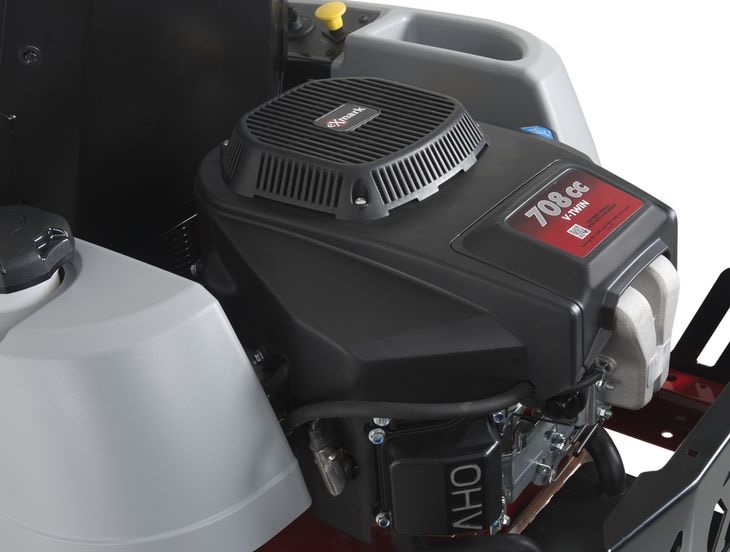
If you are not familiar with carburetor adjustment or if the issue persists after testing and cleaning the carburetor, it’s recommended to seek professional assistance or consult the Exmark dealer or service center for further troubleshooting and repair.
How to Check the Oil Level
To check the engine oil level on your Exmark lawn mower when it won’t start, follow these step-by-step instructions:
- Locate the Oil Dipstick: The oil dipstick is usually located near the engine and may have a bright-colored handle or ring for easy identification.
- Remove the Dipstick: Pull the dipstick out of its tube and wipe it clean with a cloth or paper towel. This will ensure an accurate reading.
- Reinsert the Dipstick: Fully insert the clean dipstick back into its tube until it is seated securely.
- Check the Oil Level: Remove the dipstick again and look at the oil level on the bottom end of the dipstick. The dipstick will have two marks indicating the minimum and maximum oil levels. The oil level should be between these two marks.
- Add Oil if Necessary: If the oil level is below the minimum mark, you will need to add oil. Use the recommended type and grade of oil for your Exmark lawn mower, as specified in the operator’s manual.
- Recheck the Oil Level: After adding oil, reinsert the dipstick, and then remove it again to check the oil level. Ensure the oil level is now within the acceptable range.
- Examine the Oil Condition: While checking the oil level, also inspect the oil’s condition. The oil should be clean and free from contaminants. If the oil appears dirty, gritty, or has a strong burnt smell, it may be time for an oil change.
- Inspect for Leaks: While you have the dipstick removed, take a moment to inspect the area around the oil fill cap and dipstick tube for any signs of oil leaks. If you notice any leaks, address them accordingly.
- Maintain Proper Oil Level: Maintaining the correct oil level is crucial for the proper operation and longevity of your lawn mower’s engine. Check the oil level regularly and top it up as needed.
Remember, if your Exmark lawn mower won’t start and the oil level is fine, there may be other issues causing the problem.
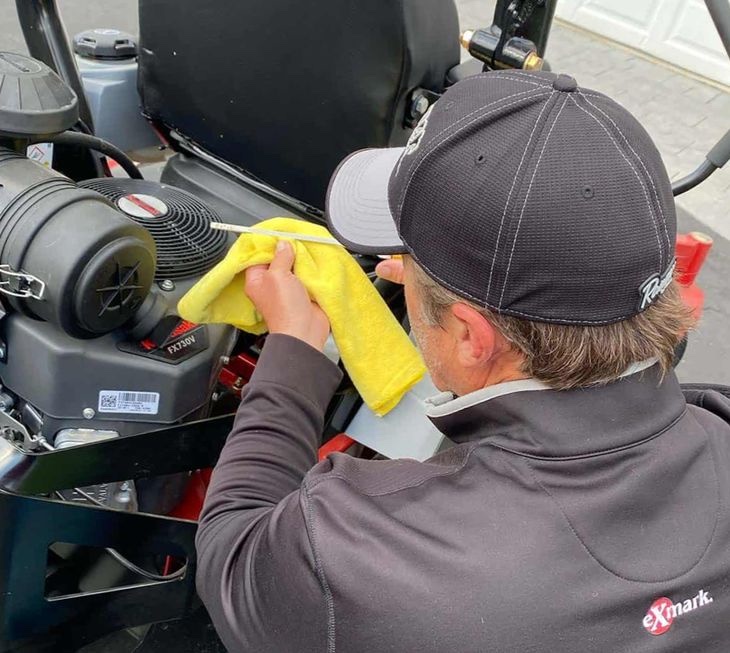
In such cases, it’s best to consult the operator’s manual for troubleshooting tips or seek professional assistance from an authorized Exmark dealer or service center.
How to Check the Safety Switch
To test a safety switch on your Exmark lawn mower, follow these step-by-step instructions:
- Locate the Safety Switch: Exmark lawn mowers have several safety switches, such as the seat switch, brake switch, and blade engagement switch. Refer to the operator’s manual to identify the location of each safety switch on your specific model.
- Inspect the Switch Mechanism: Visually inspect the safety switch to check for any visible damage, wear, or loose connections. Make sure the switch is clean and free from debris that might hinder its proper function.
- Check the Seat Switch: If your Exmark lawn mower has a seat switch, sit on the seat and try starting the engine. The seat switch prevents the engine from starting unless someone is sitting on the seat. If the engine starts with you seated, the seat switch is likely working correctly.
- Test the Brake Switch: If your lawn mower has a brake switch, engage the parking brake and try starting the engine. The brake switch prevents the engine from starting if the parking brake is not engaged. If the engine starts with the parking brake engaged, the brake switch is likely functioning correctly.
- Verify the Blade Engagement Switch: If your Exmark lawn mower has a blade engagement switch, disengage the blades and try starting the engine. The blade engagement switch prevents the engine from starting if the blades are engaged. If the engine starts with the blades disengaged, the blade engagement switch is likely working properly.
- Inspect Wiring and Connections: Check the wiring and connections associated with each safety switch. Look for loose, damaged, or corroded wires and connections. Ensure all connections are secure and in good condition.
- Test with Multimeter (Optional): If you have a multimeter and are familiar with using it, you can perform continuity tests on the safety switches to confirm their proper function. Consult the operator’s manual or seek guidance from a professional if you are unsure how to use a multimeter.
- Replace Faulty Safety Switch: If you suspect that any of the safety switches are faulty and causing the lawn mower not to start, consider replacing the defective switch with a new one. Replacement safety switches can be obtained from an authorized Exmark dealer or a reputable lawn mower parts supplier.
Always refer to the operator’s manual for specific instructions and safety precautions related to your Exmark lawn mower’s safety switches. If troubleshooting the safety switches does not resolve the starting issue, or if you are unsure about performing the tests, it’s best to seek assistance from an authorized Exmark dealer or a professional lawn mower technician.
Exmark Lawn Mower Won’t Start F.A.Q.
Frequently Asked Questions (FAQ) for Exmark Lawn Mower Won’t Start
Q1. Why won’t my Exmark lawn mower start?
A: There can be various reasons why your Exmark lawn mower won’t start, including issues with the battery, fuel system, ignition system, safety switches, or engine components. Refer to the troubleshooting guide in your operator’s manual or seek professional assistance to diagnose the specific cause.
Q2. How do I know if the battery is the problem?
A: If you turn the key, and there’s no response from the engine or you hear a clicking sound, it might indicate a weak or dead battery. You can check the battery voltage with a multimeter, or try jump-starting the mower with booster cables. If it starts with a jump, the battery may need replacement.
Q3. What should I do if the engine cranks but won’t start?
A: If the engine cranks but doesn’t start, the problem may lie in the fuel system or ignition system. Check the fuel tank for fuel and inspect the fuel filter and lines for blockages. Also, examine the spark plug for signs of wear or fouling.
Q4. Can a faulty safety switch prevent the lawn mower from starting?
A: Yes, a malfunctioning safety switch, like the seat switch or blade engagement switch, can prevent the engine from starting. Test the switches following the steps in the provided instruction to ensure they are functioning correctly.
Q5. How often should I replace the spark plug on my Exmark mower?
A: It is recommended to replace the spark plug annually or after every 100 hours of use, whichever comes first. A worn-out spark plug can lead to poor engine performance and starting issues.
Q6. What fuel should I use in my Exmark lawn mower?
A: Exmark recommends using fresh, unleaded gasoline with an octane rating of 87 or higher. Avoid using E85 fuel or gasoline containing more than 10% ethanol (E10) as it can cause damage to the engine.
Q7. Can I troubleshoot complex engine issues on my own?
A: Some basic troubleshooting can be done on your own, like checking the battery, spark plug, and air filter. However, for more complex engine issues or electrical problems, it is best to seek the assistance of a qualified lawn mower technician or an authorized Exmark dealer.
Q8. Why is regular maintenance important for my Exmark mower?
A: Regular maintenance, including oil changes, air filter cleaning/replacement, and spark plug replacement, helps keep your Exmark mower in optimal condition. Proper maintenance improves performance, prolongs engine life, and reduces the risk of starting issues.
Q9. Where can I get replacement parts for my Exmark lawn mower?
A: You can purchase genuine Exmark replacement parts from authorized dealers or reputable online suppliers. Using genuine parts ensures the quality and compatibility of the components with your mower.
Q10. Can I store my Exmark lawn mower with fuel in the tank?
A: If you plan to store your mower for an extended period, it is best to either run the fuel tank dry or add a fuel stabilizer to the gas to prevent fuel degradation and carburetor issues. Consult the operator’s manual for specific storage instructions.

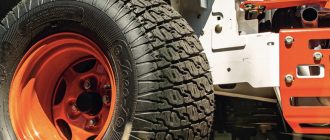
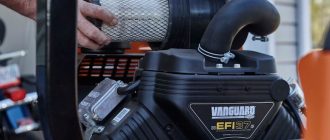


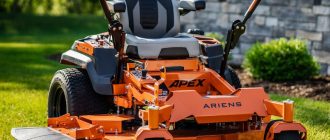
Why won’t my Exmark lawn mower start after winter storage?
If your lawn mower has been sitting idle during winter, the fuel may have degraded or water might have accumulated in the fuel system. Drain the old fuel and replace it with fresh, clean gasoline before attempting to start the engine.
What should I do if my Exmark lawn mower’s engine cranks but won’t start?
If the engine cranks but won’t start, first check the spark plug for signs of wear or fouling. Clean or replace the spark plug if necessary. Additionally, inspect the fuel filter and air filter for clogs or debris. Ensure the fuel shutoff valve is open and the fuel is reaching the carburetor. If the issue persists, consider checking the carburetor and ignition system for further troubleshooting.